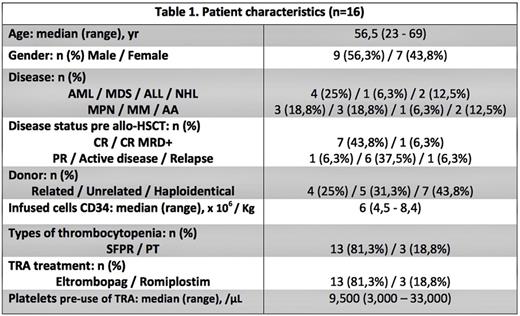Abstract
Introduction
Prolonged isolated thrombocytopenia (PT) and secondary failure of platelet recovery (SFPR) after allogeneic hematopoietic stem cell transplantation (allo-HSCT) are well known complications that could lead to a potentially lethal bleeding. To date, there are not specific guidelines for the treatment of post allo-HSCT thrombocytopenia, being platelet transfusion the mainstay of the management. Thrombopoietin receptor agonists (TRA), e.g. Eltrombopag (ETP) and Romiplostim have been approved for the treatment of primary immune thrombocytopenia and thrombocytopenia in other conditions (e.g. aplastic anemia) but information on their role in the allo-HSCT is scarce. The aims of our study were a) to analyze the effectiveness, in terms of platelet recovery and length of the response, and b) the safety profile of TRA for the treatment of thrombocytopenia after allo-HSCT in our Institution.
Methods
We performed a retrospective study on 467 patients who underwent to allo-HSCT from 2010 to 2017 in our center, of which a total of 17 patients were treated with TRA as compassionate use for thrombocytopenia after peripheral blood allo-HSCT. In order to be subsidiary to receive a TRA, patients had to be in complete remission with complete chimerism. Patients with thrombocytopenia related to cytomegalovirus and/or thrombotic microangiopathy were excluded. PT was defined as the engraftment of all peripheral blood cell lines but with a platelet (PLT) count <20,000/μL or dependence on PLT transfusions for more than 60 days after allo-HSCT. SFPR was defined as a decline in PLT count <20,000/μL for 7 consecutive days, or requirement of transfusion support after achievement of sustained PLT count ≥50,000/μL without transfusions for 7 consecutive days post-HSCT. The effectiveness or response consisted on achieving platelet recovery (≥20,000/μL) and transfusion independence of at least 7 days.
Results
Patient characteristics are detailed in table 1. One patient was excluded due to short course of treatment that was not evaluable. Platelet recovery and transfusion independence was achieved in 9 out of 16 patients (56%) with a median of 71 days (range: 8-176 days). Three of these responder-patients (R-patients) were switched to an alternative TRA in order to achieve response. Most of the R-patients had SFPR (n=7; 78%). Four patients (44%) were previously treated with mesenchymal stromal cells (MSC; n=2), immunoglobulins (n=3) and/or rituximab (n=1). The median of treatment duration was 181 days (21-350) and all R-patients (n=9) discontinued TRA. At the last follow-up, with a median of 282 days (67-1617), 7 out 9 patients (78%) maintained the response [P=152,000/μL (11,000-358,000)] and 6 (67%) are alive.
Among NR-patients (n=7; 43.7%), the median duration of TRA treatment was 14 days (8-82) and 3 patients (43%) were previously treated (MSC and/or immunoglobulins). The main characteristics of NR-patients related to poor response were: active acute graft-versus host disease (GVHD) (n=2; p=0,038), active chronic GVHD (n=1; p=0,025), decreased number of bone marrow megakaryocytes (<++) (n=6; p>0,05), 5 (71%) required platelet transfusion frequency >2 times per week (p>0,05) and all NR-patients received packed red blood cell transfusions (p=0,09). In this group, at the last follow-up, with a median of 86 days (9-144), all except one patient died due to infection (n=5; 83%) or relapse disease (n=1). Finally, no adverse events were related to TRA.
Conclusions
Treatment of thrombocytopenia after allo-HSCT with TRA is feasible. Further prospective studies are necessary to determine if these treatments may be considered as a potentially therapeutic alternative.
Sanchez-Guijo: Pfizer: Consultancy, Honoraria; Incyte: Consultancy, Honoraria; BMS: Consultancy, Honoraria; Novartis: Consultancy, Honoraria, Research Funding.
Author notes
Asterisk with author names denotes non-ASH members.


This feature is available to Subscribers Only
Sign In or Create an Account Close Modal